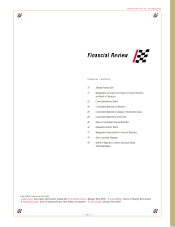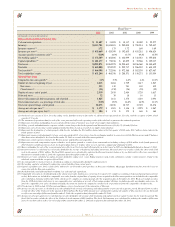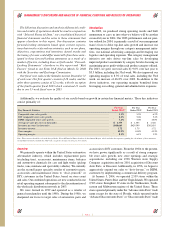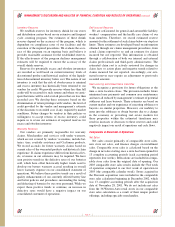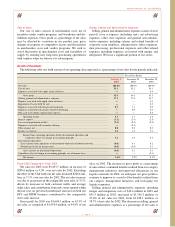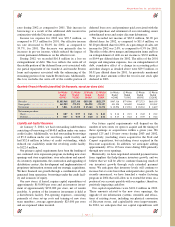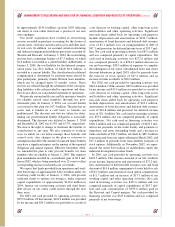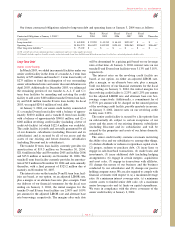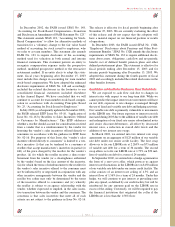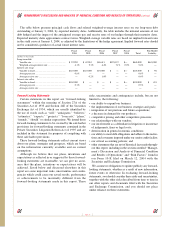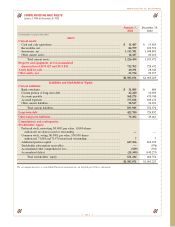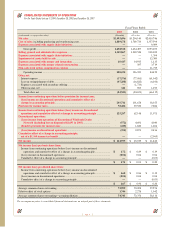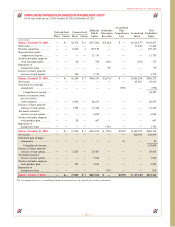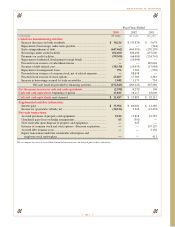Advance Auto Parts 2003 Annual Report Download - page 19
Download and view the complete annual report
Please find page 19 of the 2003 Advance Auto Parts annual report below. You can navigate through the pages in the report by either clicking on the pages listed below, or by using the keyword search tool below to find specific information within the annual report.
Quarterly Financial Results (unaudited) (in thousands, except per share data)
16-Weeks 12-Weeks 12-Weeks 13-Weeks 16-Weeks 12-Weeks 12-Weeks 12-Weeks
Ended Ended Ended Ended Ended Ended Ended Ended
4/19/03 7/12/03 10/4/03 1/3/04 4/20/02 7/13/02 10/5/02 12/28/02
Net sales ............................................... $1,005,968 $827,348 $839,101 $821,279 $967,316 $774,906 $772,723 $689,195
Gross profit........................................... 463,989 379,474 386,928 374,127 431,198 345,802 346,840 310,567
Net income ........................................... $ 5,041 $ 43,458 $ 45,164 $ 31,272 $ 12,096 $ 15,941 $ 28,363 $ 8,619
Net income per share:
Basic................................................. $ 0.07 $ 0.59 $ 0.61 $ 0.42 $ 0.18 $ 0.23 $ 0.40 $ 0.12
Diluted.............................................. $ 0.07 $ 0.58 $ 0.60 $ 0.41 $ 0.17 $ 0.22 $ 0.39 $ 0.12
rates during 2002 as compared to 2001. This increase in
borrowings is a result of the additional debt incurred in
conjunction with the Discount acquisition.
Income tax expense for 2002 was $39.5 million, as
compared to $7.3 million for 2001. Our effective income
tax rate decreased to 38.8% for 2002, as compared to
39.7%, for 2001. The decrease was primarily due to
increases in pre-tax income, which reduced the impact of
certain permanent differences on the effective rate.
During 2002, we recorded $16.8 million in a loss on
extinguishment of debt. This loss reflects the write-off of
the ratable portion of the deferred loan costs associated with
our partial repayment of our tranche A and tranche B term
loans and expenses associated with the refinancing of the
remaining portion of our tranche B term loans. Additionally,
this loss includes the write-off of the ratable portion of
deferred loan costs and premiums paid associated with the
partial repurchase and retirement of our outstanding senior
subordinated notes and senior discount debentures.
We recorded net income of $65.0 million, $0.90 per
diluted share for 2002, as compared to $11.4 million, or
$0.20 per diluted share for 2001. As a percentage of sales, net
income for 2002 was 2.0%, as compared to 0.5% for 2001.
The effect of the above merger and integration items and loss
on extinguishment of debt on net income is $32.0 million,
or $0.44 per diluted share for 2002. The effect of the 2001
merger and integration expenses, loss on extinguishment of
debt, cumulative effect of a change in accounting policy
and other charges as detailed above were $29.5 million, or
$0.51 per diluted share for 2001. As previously mentioned
these per share amounts reflect the two-for-one stock split
declared in 2003.
Page 17
Advance Auto Parts, Inc. and Subsidiaries
Liquidity and Capital Resources
At January 3, 2004, we had outstanding indebtedness
consisting of borrowings of $440.0 million under our senior
credit facility. Additionally, we had outstanding borrowings
of $5.0 million under our revolving credit facility and
had $32.6 million in letters of credit outstanding, which
reduced our availability under the revolving credit facility
to $122.4 million.
Our primary capital requirements have been the funding of
our continued store expansion program, including new store
openings and store acquisitions, store relocations and remod-
els, inventory requirements, the construction and upgrading of
distribution centers, the development and implementation of
proprietary information systems and our strategic acquisitions.
We have financed our growth through a combination of cash
generated from operations, borrowings under the credit facil-
ity and issuances of equity.
Our new stores, if leased, require capital expenditures of
approximately $150,000 per store and an inventory invest-
ment of approximately $150,000 per store, net of vendor
payables. A portion of the inventory investment is held at
a distribution facility. Pre-opening expenses, consisting
primarily of store set-up costs and training of new store
team members, average approximately $25,000 per store
and are expensed when incurred.
Our future capital requirements will depend on the
number of new stores we open or acquire and the timing of
those openings or acquisitions within a given year. We
opened 125 and 110 new stores during 2003 and 2002,
respectively, (including stores acquired in the Trak and
Carport acquisitions, but excluding stores acquired in the
Discount acquisition). In addition, we anticipate adding
approximately 125 to 135 new stores during 2004 primarily
through new store openings.
Historically, we have negotiated extended payment terms
from suppliers that help finance inventory growth, and we
believe that we will be able to continue financing much of
our inventory growth through such extended payment
terms. We anticipate that inventory levels will continue to
increase but at a rate lower than anticipated sales growth. As
recently announced, we have launched a vendor factoring
program in 2004 that will allow us to extend the terms on a
portion of our accounts payable with our suppliers, therefore,
positively impacting cash flow.
Our capital expenditures were $101.2 million in 2003.
These amounts related to the new store openings, the
upgrade of our information systems, remodels and reloca-
tions of existing stores, including our physical conversion
of Discount stores, and capitalizable store improvements.
In 2004, we anticipate that our capital expenditures will




